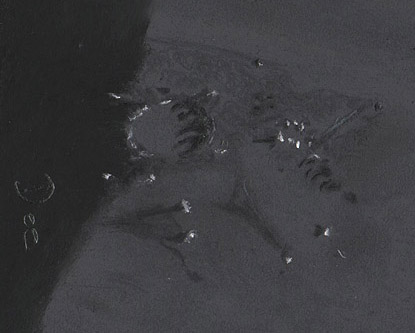
Plato sketched by Deirdre Kelleghan. February 25th 2007 20:45UT - 21:45UT, Bray Co Wicklow Ireland. 300gm, DR paper, DR soft pastels, Black watercolour pencil, wooden cocktail stick. 200mm, F6, 6.3mm Plossel/193X, Lunation 8.19days. Seeing 2, Transparency Average
Plato was sitting on the darkness of the terminator. It was a difficult choice, but I settled on Plato just because it had slightly more interesting shadows and also some very bright highlights emerging from the darkness near its northern rim. A long thin pointed shadow poured from the base of Mons Pico toward the terminator and also from another high area to its right as I viewed it. These shadows lengthened in the hour it took to do this sketch. Just above Mons Pico as I viewed, a change in the lunar surface was apparent in the form of an Eiffel tower shaped greyness which swept up to and finished at Piazzi Smith. Mons Piton sits with Piazzi in area across from Montes Alpes which had several sun kissed high points.
I observed the needle like Vallis Alpes cutting a sharp gash in the surface through rugged lunar land, lit slightly on its northern edge. Feathery shadows set of the shape of Plato and detached from its northern rim, very bright high areas warmed themselves as they became uncloaked from the blackness. Cold and cloud ended this session for me.

Moon Sheep and Plato sketched by Jane Houston Jones on November 5 2000 05:30 UTC (08:30 PM PST). This is a 9 day waxing moon. Telescope: 105mm ( or 4.1-inch) f/6 Astro Physics Traveler refractor using a 2.2mm Lanthanum eyepiece for a magnification of 276x. (Rulk 3, 4 and 11). Refractor view is reversed from reflector view in the accompanying sketch.
Note Vallis Alpes (Alpine Valley) to the left. The "sheep" are Montes Teneriffe below and to the right, Pico is the big sheep below Plato in the sketch. Piton and Monte Piazzi Smyth are above the Alpine Valley to the left. There's another Plato sketch of mine here.